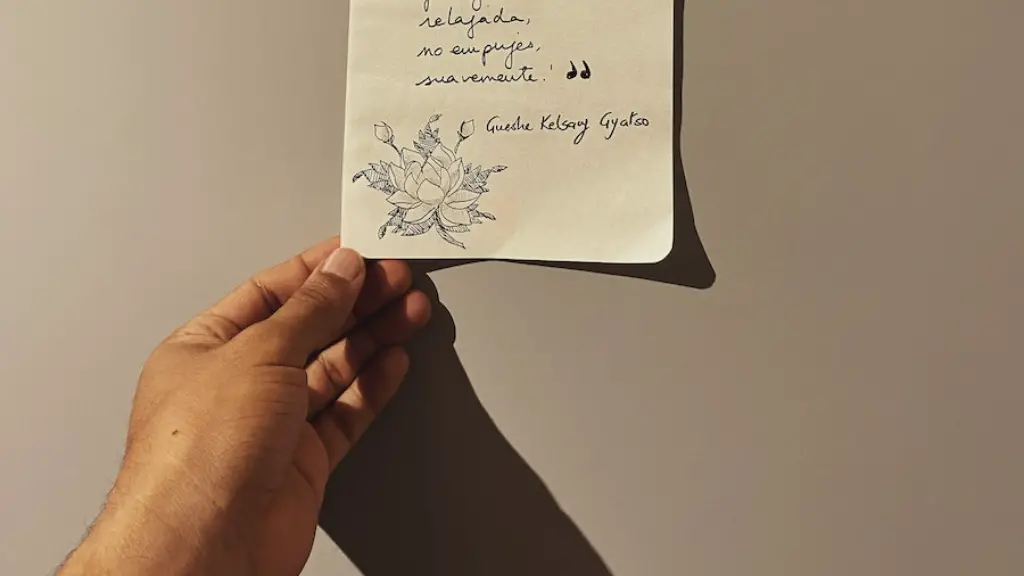Accented Syllables in Poetry
Poetry has a unique way of expressing emotion, thought, and ideas. One of the key features of this expression is the way in which syllables are emphasized, or accented. Accented syllables are the rhythm of the poem and dictate the way in which the poem should be read aloud and performed. Understanding the accentuation of syllables is crucial to understanding how to read and appreciate poetry.
Accented syllables are those that are pronounced with an emphasis. This emphasis is usually applied by increasing the duration, pitch, or volume of the syllable. This helps to draw attention to the syllable and to create a rhythm in the poem. Accented syllables often help to create a pattern that gives cadence to a piece of poetry, adding depth and character to the words.
In most cases, the accent in poetry is placed on a syllable that consists of a stressed vowel sound. This is usually the first syllable of the word, and is known as an ‘accent on the first syllable’. This can also be written as a bar over the first syllable of the word, to highlight the greater emphasis placed on it. An example of this is denoting the word ‘accident’, which would receive a greater emphasis than if it were read without the bar. An example of this in a sentence might be ‘He had an acci⁁dent’.
Poetry also uses variably accented syllables, where the accent is placed on different syllables to create a rhythm. This can be written as two bars over the accented syllables, or as a single bar over the feet of the poem. A foot is a unit of meter in which the rhythm of a poem is counted, and when reading a poem aloud, this affects the way in which the reader pronounces the words. An example of this can be seen in the phrase “The thun⁁der roars”,where the accent is on the second syllable.
When reading a poem, it is important to recognize the accented syllables in order to properly read the poem. This is because the accented syllables have the power to dictate the rhythm and emotion of the poem, and it is these elements that add complexity and depth to a poem. As such, understanding how to identify and pronounce an accented syllable is essential for appreciating poetry.
Stress vs. Accent in Poetry
It is important to differentiate between stress and accent in regards to sounding out words. Stress is the degree of emphasis placed on a particular syllable while accent is the placement of emphasis on a given syllable. Stress is indicated by writing the word with the stressed syllable in capital letters. An example of this is the word “elephant”, where the “e” sound is stressed. This does not necessarily mean that the sound should be more heavily emphasized when reading aloud, but rather that the sound should be heard more clearly.
Stress is an important element of a poem, but accent is more important for adding rhythm and emotion to a piece of writing. Accented syllables have a fixed and level emphasis, whereas stressed syllables can have varying degrees of emphasis. As such, accent is more important for understanding and appreciating poetry, as it helps to dictate the rhythm and flow of the poem.
When writing a poem, it is important to think carefully about how you want the poem to be read, and deliberately place the accent on certain syllables in order to create the desired effect. It is essential to be aware of the right combination of stress and accent in order to create the desired emotion and rhythm.
Fall vs. Spring Scansion in Poetry
In order to understand how to properly place accents in a poem, it is important to understand the two main forms of poetic meter: Fall meter and Spring meter. Fall Meter is the traditional form of poets and is often used to give an uplifting sense of motion. This is done by placing the accent on every other syllable in the poem, creating a repetitive yet uplifting rhythm. An example of this is seen in the phrase “In the sun’s bright glow”, where the accents on the words “sun’s”, “bright”, and “glow” create a sense of uplifting motion.
Spring Meter, on the other hand, is used to create a feeling of suspense or anticipation. This is done by placing the accent on the first syllable of each word in a phrase, followed by a fall meter. An example of this is seen in the phrase “Through the night”, where the accent is placed intensely on the first syllable of each word, followed by a more relaxed flow.
By understanding the difference between these forms of meter, a poet can create the desired effect in their poem by accenting certain syllables and creating a desired rhythm. The use of both Fall and Spring meters can also be used to create a feeling of contrast, which can be used to great effect in a poem.
Rhythm and Iambic Pentameter
The rhythm of a poem is highly dependent on how it is read and performed, and one of the most often used forms of meter is Iambic Pentameter. Iambic Pentameter is a rhythmic form of meter that consists of five stressed syllables and five unstressed syllables. By empahsizing the stressed syllables, it is possible to create a rhythm that gives the poem a unique flow. An example of this can be seen in the phrase “Dance with me a⁁while”, where the accent is placed on the syllable “a-”, forming an iambic pentameter.
Iambic Pentameter is widely used in poetry and literature, and is often used to great effect in order to emphasize certain ideas and emotions. By placing the accent on certain syllables, a poet can draw attention to a certain point, or create a desired flow in the poem. As such, it is important for a poet to understand how to identify and accentuate iambic pentameter, in order to create the desired effect in their poem.
Syllable Multiplication
When reading poetry, it is important to recognize that poetry can often contain multiple accents on the same syllable. This is known as syllable multiplication, and is used to create a sense of emphasis or contrast. To demonstrate this, consider the phrase “sinking⁁sh⁁ip”, where the accent is placed on the same syllable twice, creating a greater emphasis on the word.
Syllable multiplication can also be used to create contrast, by alternating the soft and hard sounds of certain words. For example, the phrase “strong si⁁lent⁁ly” can be read with a soft and then hard accent, creating a sense of contrast. By understanding syllable multiplication, a poet can emphasize certain words and phrases to create the desired emotion and flow within their poem.
Analysis and Interpretation
The way in which syllables are accented in a poem greatly affects the way in which it is read and interpreted. By understanding the different meter forms, accentuation rules, and syllable multiplication, a poet can accentuate certain syllables to create the desired emotion or contrast in the poem. This understanding is essential for appreciating poetry and understanding the subtle nuances of each poem.
Analysis of poetry often involves looking at the different accents and stresses within the poem, and understanding how they affect the flow and emotion of the piece. For example, if a poet is looking to create a feeling of anticipation or suspense, they might choose to use Spring Meter, with an emphasis on the first syllable of each word, followed by a more relaxed flow. Similarly, if a poet wants to uplift a poem, Fall Meter, with accents on every other syllable, may be more appropriate.
Interpreting poetry also requires an understanding of the different accents within the poem. The placement of certain syllable accents can provide a clue as to the intention of the poet, and can provide insight into the emotions and ideas being expressed in the poem. As such, it is important to understand how accents are used in poetry, in order to properly interpret the poem.
Conclusion
Accented syllables play an important role in poetry, and understanding how to identify and emphasize them is essential for appreciating and interpreting poetry. Through understanding the different forms of meter, and how they are used to create different emotions, a poet or reader can gain a deeper understanding of the poem and appreciate it in a new way.




